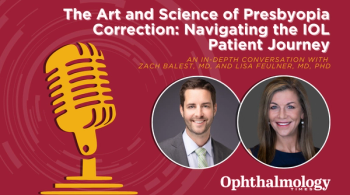
Acanthamoeba keratitis potentially devastating
Washington, DC—Maintaining an index of suspicion for Acanthamoeba infection in patients with keratitis is important, irrespective of a history of contact lens wear, because timely diagnosis and prompt treatment initiation are critical for a good prognosis, said John K. Dart, DM, FRCS, FRCOphth, at World Cornea Congress V.
Washington, DC-Maintaining an index of suspicion for Acanthamoeba infection in patients with keratitis is important, irrespective of a history of contact lens wear, because timely diagnosis and prompt treatment initiation are critical for a good prognosis, said John K. Dart, DM, FRCS, FRCOphth, at World Cornea Congress V.
"Various surveys show Acanthamoeba currently causes between 3% and 5% of all cases of microbial keratitis, and while this infection is most commonly associated with poor contact lens hygiene, up to 15% of patients with Acanthamoeba keratitis are not contact lens wearers. So, be sure to include Acanthamoeba in the differential diagnosis of atypical or persistent keratitis because amoebic keratitis therapy is much more effective when definitive treatment is initiated within 1 month of the onset of infection," said Dr. Dart, consultant ophthalmologist, Moorfields Eye Hospital, London.
Classic clinical features
Patients with Acanthamoeba keratitis present with redness, tearing, blurred vision, and pain that is often, but not invariably, severe. Radial perineuritis is a hallmark diagnostic feature that is seen early but is present in less than 50% of patients.
Cysts and trophozoites can be identified with wet mounts from contact lens cases and examination of corneal smears using periodic acid-Schiff (PAS), hematoxylin and eosin (H&E), or calcofluor white. However, the laboratory should be told Acanthamoeba is suspected to ensure that one of these stains is used.
Confocal microscopy allows immediate identification of cysts, but the examination is difficult for patients with inflamed eyes and, after therapy is started, the viability of the cysts cannot be assessed. Similarly, it is not possible to tell whether the organism is alive or dead in cysts identified in routine histologic study of corneal biopsy specimens, Dr. Dart said.
Although there are many agents with trophocidal activity, medications used to treat Acanthamoeba keratitis must be cysticidal. Among available antiamoebic agents, the biguanides, polyhexamethylene biguanide (PHMB) and chlorhexidine, have the lowest minimum cysticidal concentration (MCC) in vitro and are consistently effective against cysts in vitro. Based on MCC values, the diamidines, propamidine (Brolene) and hexamidine (Désomedine) have reasonable activity, but the cysticidal concentration is variable and many strains are resistant both in vitro and in vivo.
"It is important to know that rates of resistance to propamidine in vitro and in vivo are high, whereas our group has never seen any clinical isolates resistant to PHMB in vitro and resistance to chlorhexidine in vitro is extremely rare," Dr. Dart said.
Newsletter
Don’t miss out—get Ophthalmology Times updates on the latest clinical advancements and expert interviews, straight to your inbox.
















































.png)


